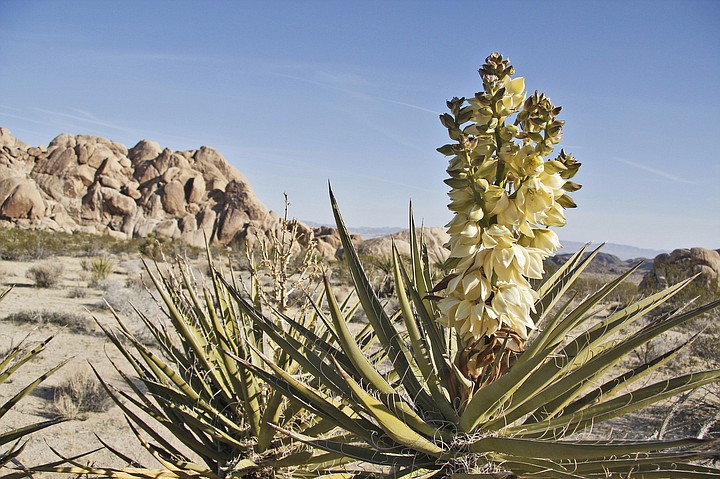 Facebook
Facebook
 X
X
 Instagram
Instagram
 TikTok
TikTok
 Youtube
Youtube

The Coastal Wildflower Bloom, a fine one on account of lots of rain and sunshine, will continue through April. One of the best spots for viewing a great variety of flowers is Torrey Pines State Reserve. San Onofre State Beach, just north of Camp Pendleton, should have acres and acres of monkeyflower, in a half-dozen different shades, blooming on the coastal bluffs. On grassy hillsides in Los Peñasquitos Canyon Preserve and in Mission Trails Regional Park (especially in the “grasslands” behind the Old Mission Dam), you might find carpets of California poppies, purple nightshade, pinkish owl’s clover, blue-colored lupine, and scattered splashes of color from a dozen or more other species of wildflowers. North County residents should check out the huge Daley Ranch preserve in northeast Escondido. Its rolling hillsides and grassy meadows should sport an impressive display of wildflowers by mid-April.

Yuccas of two varieties are in bloom in San Diego County from now through May. Year after year, the Mojave yucca (Yucca schidigera) sends up a blunt flower stalk of white, waxy blossoms from the same base -- a rosette of daggerlike leaves. The shimmering white exclamation point that unfolds above “Our Lord’s Candle” (Yucca whipplei), on the other hand, is a prelude to the plant’s imminent death. Mojave yucca is widely distributed along San Diego County’s coastal strip and throughout the higher elevations of the Anza-Borrego Desert. Our Lord’s Candle prefers the scrubby coastal foothills and the drier slopes of the Palomar, Cuyamaca, and Laguna mountains. The two yuccas coexist with each other in a few areas like Torrey Pines State Reserve and Anza-Borrego’s Culp Valley area.
Less Rain, warmer temperatures, and hazier skies coincide with the subtle onset of San Diego’s spring season. By April’s end, the alternating periods of rainfall and crystal-clear skies we’ve been having will likely be distant memories. The nocturnal, low overcast starting to hug the coast right about now will gradually build into “May Gray” and “June Gloom”— days-long episodes of perpetual overcast that can dog us through the late spring.


The Coastal Wildflower Bloom, a fine one on account of lots of rain and sunshine, will continue through April. One of the best spots for viewing a great variety of flowers is Torrey Pines State Reserve. San Onofre State Beach, just north of Camp Pendleton, should have acres and acres of monkeyflower, in a half-dozen different shades, blooming on the coastal bluffs. On grassy hillsides in Los Peñasquitos Canyon Preserve and in Mission Trails Regional Park (especially in the “grasslands” behind the Old Mission Dam), you might find carpets of California poppies, purple nightshade, pinkish owl’s clover, blue-colored lupine, and scattered splashes of color from a dozen or more other species of wildflowers. North County residents should check out the huge Daley Ranch preserve in northeast Escondido. Its rolling hillsides and grassy meadows should sport an impressive display of wildflowers by mid-April.

Yuccas of two varieties are in bloom in San Diego County from now through May. Year after year, the Mojave yucca (Yucca schidigera) sends up a blunt flower stalk of white, waxy blossoms from the same base -- a rosette of daggerlike leaves. The shimmering white exclamation point that unfolds above “Our Lord’s Candle” (Yucca whipplei), on the other hand, is a prelude to the plant’s imminent death. Mojave yucca is widely distributed along San Diego County’s coastal strip and throughout the higher elevations of the Anza-Borrego Desert. Our Lord’s Candle prefers the scrubby coastal foothills and the drier slopes of the Palomar, Cuyamaca, and Laguna mountains. The two yuccas coexist with each other in a few areas like Torrey Pines State Reserve and Anza-Borrego’s Culp Valley area.
Less Rain, warmer temperatures, and hazier skies coincide with the subtle onset of San Diego’s spring season. By April’s end, the alternating periods of rainfall and crystal-clear skies we’ve been having will likely be distant memories. The nocturnal, low overcast starting to hug the coast right about now will gradually build into “May Gray” and “June Gloom”— days-long episodes of perpetual overcast that can dog us through the late spring.
Comments